Gigantopelta chessoia
Gigantopelta chessoia is a species of deep sea snail from hydrothermal vents, a marine gastropod mollusk in the family Peltospiridae.[1]
| Gigantopelta chessoia | |
|---|---|
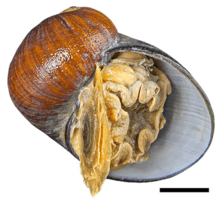 | |
| Gigantopelta chessoia The scale bar is 1 cm. | |
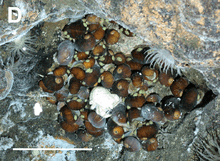 | |
| View of a number of Gigantopelta chessoia (the brown snails) partially covered by limpets Lepetodrilus sp. (the small yellow-greenish oval shapes) at the East Scotia Ridge E2 hydrothermal vent site in the Scotia Sea. The scale bar is 10 cm. | |
| Scientific classification | |
| Kingdom: | |
| Phylum: | |
| Class: | |
| (unranked): | clade Vetigastropoda |
| Superfamily: | |
| Family: | |
| Genus: | |
| Species: | G. chessoia |
| Binomial name | |
| Gigantopelta chessoia Chen, Linse, Roterman, Copley & Rogers, 2015[1] | |
Taxonomy
The first information about this species, under the name "Peltospiroidea n. sp." or "peltospiroid gastropod", was published on 3 January 2012.[2] Peltospiroidea is the name of a superfamily of gastropods that was used in the taxonomy of the Gastropoda (Ponder & Lindberg, 1997). It contained the only extant family Peltospiridae (and some prehistoric gastropod families). However, the taxonomy of the Gastropoda (Bouchet & Rocroi, 2005) does not use the name Peltospiroidea (in that system, the family Peltopiridae is placed within the Neomphaloidea).
It was described as a new species within new genus Gigantopelta in 2015 and it was classified within the family Peltospiridae.[1]
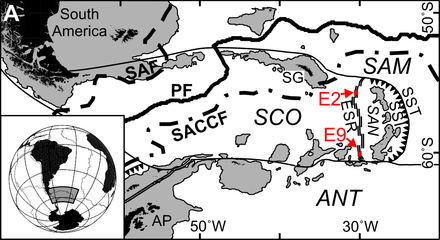
Distribution
This species is known from two sites near hydrothermal vents in the East Scotia Ridge of the south Atlantic Ocean: from 2,394 m depth at the E9 vent site and from the 2,608 m depth at the E2 site.[2]
Description
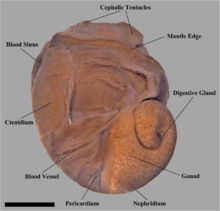
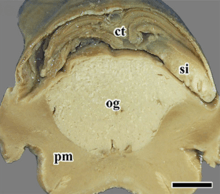
ct – ctenidium,
si – blood sinus,
pm – pedal muscle.
The scale bar is 1 cm.
The color of the shell is dark olive.[1] The shell has three to four whorls.[1] The width of the shell is from 4.21–45.7 mm.[1] Body size of the juvenile snail is 2 mm,[3] while body size of the adult is 50 mm.[3]
It has non-papillate tentacles.[3]
The digestive system: there is one pair of radula cartilages.[3] The digestive tract is short and consist of a single loop.[3] The rectum does not penetrate the heart.[3] The radula consist of 1.4% of body volume in juveniles and radula cartilages consist of 2.6% of body volume in juveniles.[3]
The respiratory system consist of single left bipectinate ctenidium (gill).[3]
The circulatory system is hypertrophied: heart is greatly enlarged.[3] The ventricle is 0.42 mm in juvenile animal length of 2.0 mm.[3] The ventricle grows to the size 6 mm in adults.[3] There is a single left auricle.[3] Gigantopelta chessoia has symbiotic bacteria in its enlarged oesophageal gland.[4] The body of Gigantopelta chessoia has low values of carbon isotope δ13C.[5] This indicates that carbon fixation in Gigantopelta chessoia can occur via Calvin-Benson-Bassham cycle by endosymbiotic Gammaproteobacteria.[5] The occurrence of endosymbiont bacteria in the oesophageal gland was confirmed by transmission electron microscopy in 2017.[3]
The oesophageal gland is fused and enlarged to fill the entire ventral side of mantle cavity.[3] It is occupying 0.6% of visceral mass volume in juveniles, while it is increasing allometrically up to 9% visceral mass volume in adults.[3] Blood sinuses are large, but few and fixed in position.[3]
The nervous system has ganglia.[3]
The sensory organs of Gigantopelta chessoia include statocysts with statolith.[3]
The reproductive system has fully developed gonads in juveniles at body size 2.0 mm.[3]
Ecology
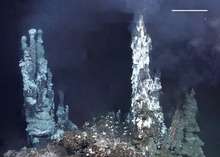
This gastropod is generally found in dense aggregations up to ~1,000 m−2.[2]
Small limpets Lepetodrilus sp. East Scotia Ridge are sometimes found on the shells of Gigantopelta chessoia.[2] Other marine fauna, such as actinostolid sea anemones (family Actinostolidae), crabs in the genus Kiwa, and the pycnogonid arthropod or "sea spider" cf. Sericosura, can be found living together with this species.[2]
Gigantopelta chessoia may be a mixotroph in juvenile life and shifting to obligate symbiotrophy as an adult.[3]
Gigantopelta chessoia is gonochoristic (they have distinct males and females).[3]
References
This article incorporates Creative Commons (CC-BY-2.5) text from the reference[2] and CC-BY-4.0 text from the reference[3]
- Chen C., Linse K., Roterman C. N., Copley J. T. & Rogers A. D. (2015). "A new genus of large hydrothermal vent‐endemic gastropod (Neomphalina: Peltospiridae)". Zoological Journal of the Linnean Society 175(2), 319-335. doi:10.1111/zoj.12279.
- Rogers A.D., Tyler P.A., Connelly D.P., Copley J.T., James R., Larter R.D., Linse K., Mills R.A., Garabato A.N., Pancost R.D., Pearce D.A., Polunin N.V., German C.R., Shank T., Boersch-Supan P.H., Alker B.J., Aquilina A., Bennett S.A., Clarke A., Dinley R.J., Graham A.G., Green D.R., Hawkes J.A., Hepburn L., Hilario A., Huvenne V.A., Marsh L., Ramirez-Llodra E., Reid W.D., Roterman C.N., Sweeting C.J., Thatje S. & Zwirglmaier K. (2012). "The Discovery of New Deep-Sea Hydrothermal Vent Communities in the Southern Ocean and Implications for Biogeography". PLoS Biology 10(1): e1001234. doi:10.1371/journal.pbio.1001234.
- Chen, Chong; Uematsu, Katsuyuki; Linse, Katrin; Sigwart, Julia D. (2017). "By more ways than one: Rapid convergence at hydrothermal vents shown by 3D anatomical reconstruction of Gigantopelta (Mollusca: Neomphalina)". BMC Evolutionary Biology. 17 (1): 62. doi:10.1186/s12862-017-0917-z. ISSN 1471-2148. PMC 5333402. PMID 28249568.
- "This Snail Goes Through Metamorphosis. Then It Never Has to Eat Again". Retrieved 2018-07-13.
- Reid W. D. K., Sweeting C. J., Wigham B. D., Zwirglmaier K., Hawkes J. A., McGill R. A. R, Linse K. & Polunin N. V. C. (2013). "Spatial Differences in East Scotia Ridge Hydrothermal Vent Food Webs: Influences of Chemistry, Microbiology and Predation on Trophodynamics". PLoS ONE 8(6): e65553. doi:10.1371/journal.pone.0065553.
External links
| Wikimedia Commons has media related to Gigantopelta chessoia. |
- Heywood J. L., Chen C., Pearce D. A. & Linse K. (2017). "Bacterial communities associated with the Southern Ocean vent gastropod, Gigantopelta chessoia: indication of intergenerational, horizontal symbiont transfer". Polar Biology. doi:10.1007/s00300-017-2148-6.
- Marsh L., Copley J. T., Huvenne V. A. I., Linse K., Reid W. D. K., Rogers A. D., Sweeting C. J. & Tyler P. A. (2012). "Microdistribution of faunal assemblages at deep-sea hydrothermal vents in the Southern Ocean". PLoS ONE 7: e48348. doi:10.1371/journal.pone.0048348
- Reid W. D. K., Sweeting C. J., Wigham B. D., McGill R. A. R. & Polunin N. V. C. (2016). "Isotopic niche variability in macroconsumers of the East Scotia Ridge (Southern Ocean) hydrothermal vents: What more can we learn from an ellipse?" Marine Ecology Progress Series 542: 13-24. doi:10.3354/meps11571